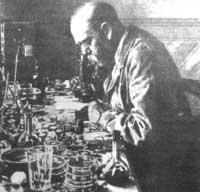Robert Koch
Elhuyar Fundazioa
Koch had twelve brothers and as a young man showed a tendency to medicine. At the University of Göttingen he had professors from Wöhler and Henle and in 1866 he finished his career with very brilliant notes.
Although he was a doctor, he wanted to be an explorer, to find new places around the world. However, his wife removed those intentions from her head and began working as a doctor. (Then she left her wife, divorced and married a girl much younger than her.)
He participated as a military doctor in the war between France and Prussia helping the Prussians. He was then an agricultural doctor in the Breslau area of Silesia. There, a so-called satar hit the cattle and Koch began to analyze it. In 1876 he discovered that the disease was caused by bacteria in the spleen of cattle. This bacterium was applied to rats and thus the smoothie was contaminated, finally appearing the same bacteria.

Another important advance was the growth of bacteria outside the animal body. For this purpose he used the sero of blood heated to the body temperature. Through this system, he was able to analyze the entire life of the mole bacteria and discover the spores that were fighting it.
Koch expanded his fame and had the opportunity to go live and work in Berlin. There he used aniline dyes to study bacteria. Unstained bacteria are semi-transparent and difficult to see.
To study bacteria outside the body, Koch used liquids, but later began to grow in solids because it was more appropriate. He raised them in jelly. Koch used glass launas to grow bacteria, but his assistant, Julius Richard Petri, replaced them with glass boxes with a lid, which is the system that is still being used.
In the jellies the bacteria could not move and there it divided over and over again forming a bacterial colony. In this way it was possible to introduce these bacteria to animals, always knowing for sure what type they were.
Koch, through his standards and techniques, isolated and identified bacteria from different diseases. In 1882 he discovered the bacillus of tuberculosis and in 1890 he believed that it was the remedy of this terrible disease. But the remedy was not as good as he thought.
In 1883 he travelled to Asia to study black plague and cholera. He also investigated the evil of logic in Africa. He was awarded for finding the bacillus of cholera. He later found that between 1897 and 1906 the black plague was transmitted through rat fleas and sleep disease through the tsetse fly.
In 1905, Dr. Robert Koch received the Nobel Prize in Medicine and Physiology for his discoveries in the field of tuberculosis.
He died in the German city of Baden-Baden on 27 May 1910.





